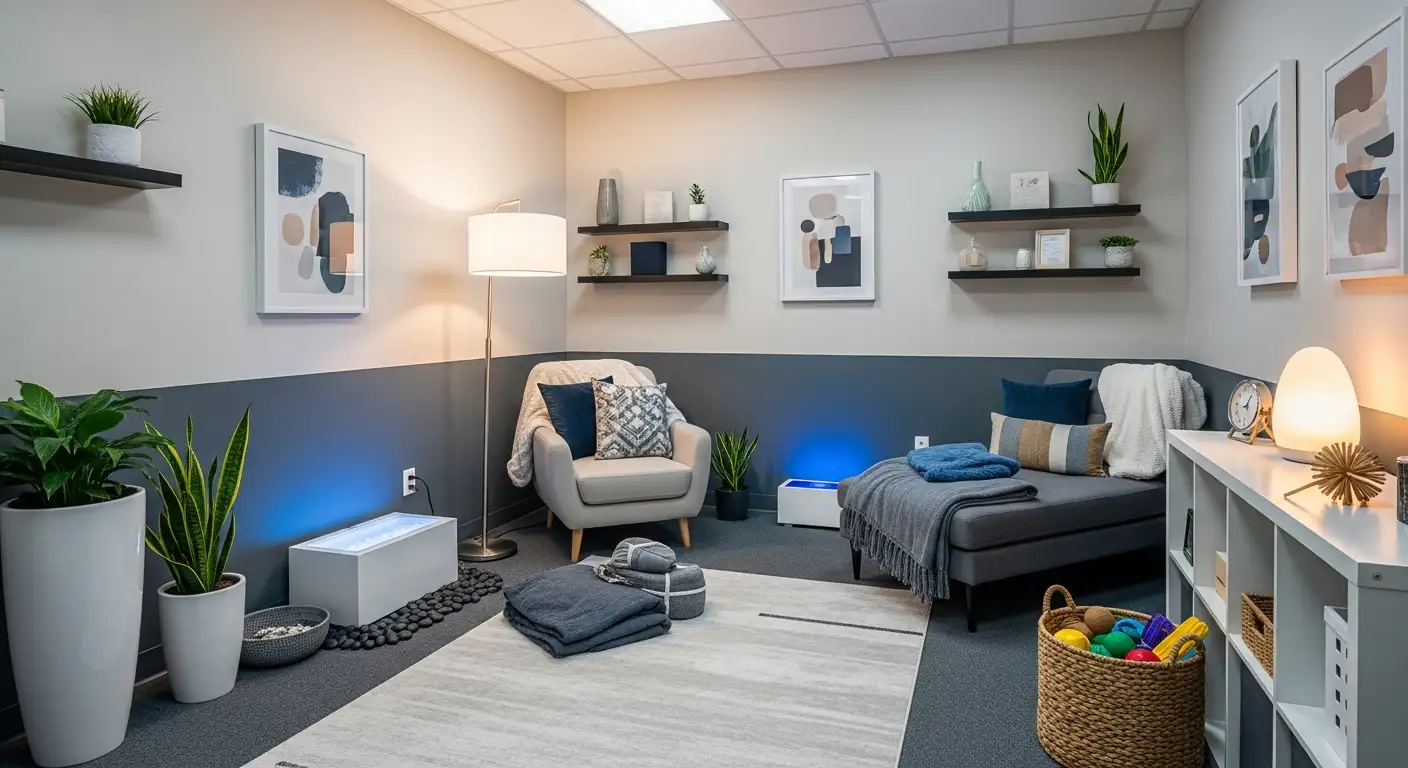Introduction to Sound Sensitivity in Autism
Sound sensitivity is a prevalent and challenging aspect of Autism Spectrum Disorder (ASD), affecting a significant number of individuals. This phenomenon can manifest as hypersensitivity, where everyday sounds are perceived as overwhelmingly loud, or as hyposensitivity, where sounds may be largely ignored. Understanding the nuances of this condition is crucial for developing effective management strategies to improve the quality of life for those affected.
Manifestations of Sound Sensitivity in Autism

How does sound sensitivity manifest differently in individuals with autism?
Sound sensitivity in individuals with autism spectrum disorder (ASD) can present in varying degrees, classified as hyper-responsiveness or hypo-responsiveness. Hyper-responsive individuals typically react strongly to noise, often covering their ears or fleeing from loud environments. For instance, many children may appear distressed in settings like classrooms, where everyday sounds (like rustling papers) can become overwhelming.
Conversely, hypo-responsive individuals may underreact to sounds. These children might demonstrate a lack of attention to auditory stimuli, engaging in behaviors such as seeking out loud noises or showing a reduced response to auditory cues that would typically elicit reactions in neurotypical peers.
Behaviors indicative of hypersensitivity and hyposensitivity
Behaviors reflecting hypersensitivity can include:
- Covering ears or shutting down in noisy settings.
- Having meltdowns or displays of anxiety when confronted with unexpected sounds.
- Displaying startle reactions to sudden noise.
In contrast, signs of hyposensitivity may manifest as:
- An apparent inability to notice or react to sounds, such as failing to respond when called.
- A tendency to engage with loud, jarring noises, showing enjoyment rather than distress.
How does sound sensitivity impact daily life for individuals with autism?
Sound sensitivity significantly impacts daily life for individuals with autism by leading to discomfort and sensory overload in various settings. Nearly 90% of autistic individuals experience some degree of sensory hypersensitivity, with sound being one of the most commonly affected senses. This heightened sensitivity can cause distress, anxiety, and difficulty in social and educational environments, as individuals may struggle to filter out background noise. Common reactions include covering ears, expressing discomfort, or even experiencing meltdowns in noisy situations. Management strategies such as using noise-canceling headphones, creating quiet spaces, and employing cognitive behavioral therapy can help individuals cope with the challenges posed by sound sensitivity.
Prevalence and Factors Contributing to Auditory Sensitivity

Prevalence of Sound Sensitivity Among Autistic Individuals
Research indicates that auditory sensitivity is common among individuals with autism, affecting between 30% and 90% of this population. This means that a significant majority may either ignore or overreact to sound stimuli, leading to challenges in daily life. Specifically, studies show that 50 to 70 percent of autistic individuals experience hypersensitivity, commonly illustrated through behaviors like covering their ears in response to loud noises or displaying distress in busy environments.
Factors That Contribute to Sound Sensitivity Including Neurological and Genetic Components
Neurological differences play a crucial role in sound sensitivity for those on the spectrum. For example, studies have shown heightened activity in the amygdala, a region linked to emotional responses, when autistic individuals are exposed to sounds. This suggests altered processing of auditory information compared to neurotypical peers. Furthermore, genetic factors are being researched to ascertain their impact on auditory processing. The Shank3 protein has been identified as influential in the nervous system's circuits related to sensory perception, indicating potential pathways for examining sound sensitivity in autism.
To manage these sensitivities, effective strategies include tailoring environments to reduce extraneous noise, using noise-canceling headphones, and engaging in calming activities. Understanding that these auditory sensitivities are prevalent can assist caregivers and educators in supporting autistic individuals more effectively.
Understanding Hyperacusis in Autism
What is hyperacusis?
Sound sensitivity in autism is commonly referred to as hyperacusis. This condition is characterized by an increased sensitivity to everyday sounds, making them feel much louder than they actually are, and can sometimes cause discomfort or pain. Common sources of distress for individuals with hyperacusis include:
- Barking dogs
- Vacuum cleaners
- Chewing noises
Hyperacusis can develop gradually or appear suddenly. Many individuals may find themselves avoiding noisy environments, which can ultimately lead to social isolation. Understanding and recognizing these reactions is crucial for support and intervention.
What impact does hyperacusis have on individuals with autism?
The impact of hyperacusis on individuals with autism spectrum disorder (ASD) can be profound. It can interfere with:
- Daily Activities: Tasks such as attending school or social events become challenging due to overwhelming noise levels.
- Communication: Difficulty hearing and processing information increases when exposed to disruptive sounds.
- Social Interactions: Individuals may withdraw from social activities to escape distressing noise, leading to isolation.
Management strategies can include sound therapy, cognitive behavioral therapy (CBT), and practical approaches like using noise-canceling headphones or creating quiet spaces. These interventions help lessen the impact of hyperacusis and improve quality of life for individuals with autism.
Mechanisms Behind Auditory Sensitivity in Autism
Why are autistic people sensitive to sound?
Autistic individuals often experience sensitivity to sound due to differences in how their brains process auditory stimuli. Research shows that approximately 50 to 70 percent may exhibit hypersensitivity, reacting with fear or discomfort to everyday sounds, which can significantly impact their daily lives.
These individuals find it challenging to filter distracting noises, leading to extreme discomfort or behavioral issues. While many children naturally adapt to repetitive sounds, those on the autism spectrum might not, showing heightened reactions even after exposure. This inability to acclimate may stem from inherent differences in their sensory processing systems.
Neurological and physiological explanations
Scientific research has uncovered that autistic children may exhibit increased neurological responses to sounds. Imaging studies reveal that areas of the brain, such as the amygdala, show heightened activity when these individuals are exposed to sound stimuli, suggesting a divergence in sensory information processing.
Furthermore, the strong physiological reactions observed—like increased heart rate or sweat gland activity—during auditory exposure indicate a pronounced autonomic nervous system response. These reactions often differ from those of neurotypical peers, exacerbating feelings of anxiety and leading to distress in environments with excessive noise.
The role of autonomic systems in sound sensitivity
Children with autism showcase divergent autonomic responses to sound. Studies indicate that their autonomic nervous systems react more intensely when exposed to noise, resulting in observable signs of stress, such as covering their ears or fleeing from loud locations.
This heightened sensitivity is not just emotional; it has a physiological basis. Autistic individuals demonstrate prominent responses that can lead to sensory overload, significantly affecting their ability to engage in social and daily activities. As research continues to explore the connections between genetics, auditory processing, and emotional regulation, it emphasizes the need for tailored coping strategies to support those with sound sensitivity.
Conditions Related to Sound Sensitivity
What is Hyperacusis, Misophonia, and Phonophobia?
Hyperacusis, misophonia, and phonophobia are three closely related conditions that contribute to sound sensitivity in individuals with autism.
- Hyperacusis is characterized by an increased sensitivity to sounds that others may find normal. Everyday noises can feel unbearable or painful, leading to significant discomfort and distress.
- Misophonia triggers intense emotional reactions to specific sounds, such as chewing or typing, often resulting in avoidance behaviors that can severely disrupt social interactions.
- Phonophobia is defined as a fear of certain sounds, which can result in anxiety and avoidance of environments where these sounds are present.
These conditions highlight the varied nature of sound sensitivity in autistic individuals, emphasizing the need for tailored management strategies.
Emotional and Behavioral Responses to Sound Sensitivity
The emotional and behavioral responses to sound sensitivity can be profound and complex. Many children with autism respond to sounds with behaviors such as covering their ears, leaving the room, or displaying agitation.
- Individuals experiencing hyperacusis may react with panic or severe discomfort, causing them to withdraw from social situations.
- Those with misophonia often exhibit frustration or anger towards specific noises, which can escalate to meltdowns in uncontrolled environments.
- Phonophobia can lead to increased avoidance behaviors, making it difficult for individuals to engage in otherwise enjoyable activities due to fear of sound.
Overall, these sensory sensitivities contribute to considerable anxiety, discomfort, and potential social isolation, impacting day-to-day functioning and emotional well-being among autistic individuals.
| Condition | Description | Common Reactions |
|---|---|---|
| Hyperacusis | Difficulty with normal sounds perceived as painful | Covering ears, fleeing from sound sources |
| Misophonia | Extreme emotional response to specific trigger sounds | Agitation, avoidance of social settings |
| Phonophobia | Fear and anxiety related to certain sounds | Avoidance of known sound triggers, heightened anxiety |
This categorization aids in understanding and addressing the specific challenges faced by individuals with autism related to sound sensitivity.
Impact of Sound Sensitivity on Learning and Socialization

Challenges in Educational Settings
Sound sensitivity can create significant challenges for children with autism in educational environments. Many autistic children experience hyper-responsiveness to sounds, making tasks like listening to a teacher in a busy classroom extremely difficult. Reports indicate that between 50% and 70% of autistic individuals experience discomfort from everyday noises, leading to distress and difficulties focusing during lessons. In scenarios where children cover their ears or retreat from noisy areas, their ability to learn can be severely hampered.
Additionally, the presence of loud sounds, such as school bells or chatter, can induce stress or anxiety. This heightened sound sensitivity can result in behavioral meltdowns, further disrupting not only their learning but also the learning environment for others.
Effects on Social Interactions and Relationships
Sound sensitivity impacts social interactions for autistic individuals as well. When children flee from conversations or cover their ears in response to sounds, it can lead to misunderstandings with peers, making socialization challenging. Many children find it difficult to engage in group activities, often resulting in feelings of isolation or frustration.
Furthermore, the emotional responses tied to sound sensitivity, such as fear or irritation, can complicate their ability to form friendships. Classroom dynamics can suffer when a child withdraws due to overwhelming sensory experiences, potentially leading to long-term impacts on their social development.
Exploring Treatments for Sound Sensitivity

What treatments are available for autism noise sensitivity?
Treatments for autism noise sensitivity, commonly termed hyperacusis, employ diverse strategies adapted to the unique needs of individuals. Cognitive Behavioral Therapy (CBT) proves effective, enabling individuals to acquire coping skills and address anxiety linked to sound sensitivity.
In addition to therapy, several practical techniques exist that provide immediate relief:
- Noise-canceling headphones: These can significantly reduce exposure to overwhelming sounds.
- Earplugs: Useful for dampening noise in various environments.
- Establishing quiet spaces: A dedicated area where the person can retreat during stressful situations is vital.
- Safe places: Creating lists of noise-friendly environments can help individuals feel secure.
- Gradual exposure therapy: This involves systematically introducing feared sounds in a controlled setting to aid desensitization.
What practical solutions can help individuals and families manage sound sensitivity?
Occupational therapists often recommend tailored sensory integrative strategies that promote comfort while addressing noise sensitivity. Techniques might include deep pressure techniques or structured activities aimed at building resilience against sound stimuli.
Some families explore nutritional supplements or dietary adjustments to support overall well-being. However, it's crucial to consult healthcare professionals to ensure that interventions are appropriate and effective.
In essence, the landscape of treatments for sound sensitivity in autism encompasses a blend of therapeutic, practical, and lifestyle adaptations that collectively promote harmony in day-to-day life.
Personal Accounts and Research Insights

Experiences from individuals and families
Many families of children on the autism spectrum report distinctive challenges associated with sound sensitivity. Common accounts often include children covering their ears during simple daily activities, like school events or family gatherings. These reactions are not just behavioral; parents observe heightened emotional responses, such as distress or anxiety, when encountering loud environments.
For instance, one parent shared that their child would become visibly agitated with the combination of school cafeteria noise and background chatter. These sensory overload experiences can lead to meltdowns, prompting families to implement strategies to navigate busy settings effectively.
Findings from recent studies on sound sensitivity in autism
Research has revealed that a significant percentage of individuals with autism—between 30% to over 90%—experience varying degrees of sound sensitivity. Studies indicate that many children either ignore or overreact to everyday sounds, making auditory processing a critical area of focus in therapies.
Specifically, recent findings show that around 50-70% of children with autism may face hypersensitivity to sound, with some exhibiting profound difficulties in managing auditory environments. Increasingly, audiologists recommend strategies such as using noise-canceling headphones to help mitigate the overwhelming effects of sound stimuli.
What strategies can help manage sound sensitivity in autism?
Managing sound sensitivity in autism can be effectively addressed through the use of noise-canceling headphones.
These headphones, available in Active Noise Cancelling (ANC) and Passive Noise Isolation (PNI) types, help reduce sensory overload and provide relief by blocking or neutralizing uncomfortable noises.
Many individuals on the autism spectrum report improvements in focus, relaxation, and overall quality of life when using these headphones.
When selecting headphones, factors such as comfort, type, sound quality, and ease of use are crucial, with options available for different preferences and budgets.
Research supports the benefits of noise-canceling headphones, indicating they can significantly alleviate stress associated with sound sensitivity in autistic individuals.
Conclusion: Towards Better Understanding and Support
Sound sensitivity in autism presents unique challenges but also opportunities for intervention and support that can enhance daily living. As research continues to shed light on the mechanisms behind these sensitivities, an evolving array of personalized strategies and therapies promises to bring relief and greater social participation for those affected. Education, empathy, and proactive management options pave the path towards more inclusive environments and improved quality of life for individuals with autism.
References
- What Do We Know About Noise Sensitivity In Autism?
- What Do We Know About Noise Sensitivity in Autism?
- Autism and Sound Sensitivity: Why it Happens and Coping Tips
- A Review of Decreased Sound Tolerance in Autism - PubMed Central
- Sensory issues - Autism Speaks
- Autism and Sound Sensitivity: Understanding Responses to Noise
- Sensory differences - a guide for all audiences
- Hyperacusis in Autism Spectrum Disorders - PMC - PubMed Central






